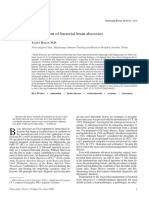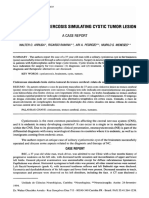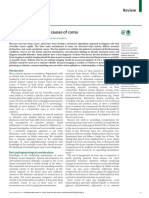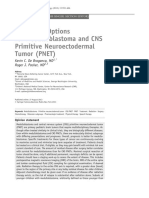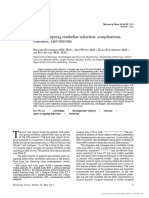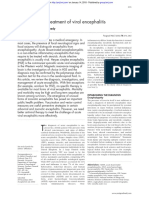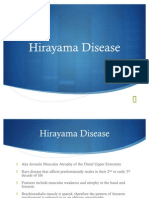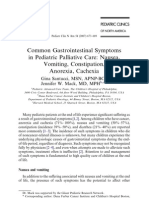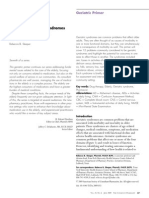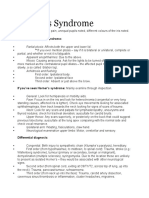Community-Acquired Bacterial Meningitis in Adults: Review Article
Community-Acquired Bacterial Meningitis in Adults: Review Article
Uploaded by
Álvaro NBCopyright:
Available Formats
Community-Acquired Bacterial Meningitis in Adults: Review Article
Community-Acquired Bacterial Meningitis in Adults: Review Article
Uploaded by
Álvaro NBOriginal Title
Copyright
Available Formats
Share this document
Did you find this document useful?
Is this content inappropriate?
Copyright:
Available Formats
Community-Acquired Bacterial Meningitis in Adults: Review Article
Community-Acquired Bacterial Meningitis in Adults: Review Article
Uploaded by
Álvaro NBCopyright:
Available Formats
The n e w e ng l a n d j o u r na l of m e dic i n e
review article
current concepts
Community-Acquired Bacterial Meningitis
in Adults
Diederik van de Beek, M.D., Ph.D., Jan de Gans, M.D., Ph.D.,
Allan R. Tunkel, M.D., Ph.D., and Eelco F.M. Wijdicks, M.D., Ph.D.
B
From the Department of Neurology, Cen- acterial meningitis is a medical, neurologic, and sometimes
ter of Infection and Immunity Amsterdam, neurosurgical emergency that requires a multidisciplinary approach. Bacterial
Academic Medical Center, University of
Amsterdam, Amsterdam (D.B., J.G.); the De- meningitis has an annual incidence of 4 to 6 cases per 100,000 adults (defined
partment of Medicine, Monmouth Medi- as patients older than 16 years of age), and Streptococcus pneumoniae and Neisseria
cal Center, Long Branch, N.J. (A.R.T.); and meningitidis are responsible for 80 percent of all cases.1,2 A diagnosis of bacterial
the Department of Neurology, Division of
Critical Care Neurology, Mayo Clinic College meningitis is often considered, but the disease can be difficult to recognize.1-8 Rec-
of Medicine, Rochester, Minn. (E.F.M.W.). ommendations for antimicrobial therapy are changing as a result of the emergence
Address reprint requests to Dr. van de Beek of antimicrobial resistance. In this review we summarize the current concepts of
at the Department of Neurology H2, Aca-
demic Medical Center, University of Am- the initial approach to the treatment of adults with bacterial meningitis, highlighting
sterdam, P.O. Box 22660, 1100 DD Amster- adjunctive dexamethasone therapy and focusing on the management of neurologic
dam, the Netherlands, or at d.vandebeek@ complications.
amc.uva.nl.
N Engl J Med 2006;354:44-53. initial approach
Copyright © 2006 Massachusetts Medical Society.
In adults presenting with community-acquired acute bacterial meningitis, the sen-
sitivity of the classic triad of fever, neck stiffness, and altered mental status is low
(44 percent), but almost all such patients present with at least two of four symptoms
— headache, fever, neck stiffness, and altered mental status (as defined by a score
below 14 on the Glasgow Coma Scale).1 Lumbar puncture is mandatory in any pa-
tient in whom bacterial meningitis is suspected, although the procedure can be
hazardous (Fig. 1 in the Supplementary Appendix, available with the full text of this
article at www.nejm.org). Reports have emphasized the risk of brain herniation as
a complication of diagnostic lumbar puncture in patients with meningitis.9-13 Pa-
tients with expanding masses (e.g., subdural empyema, brain abscess, or necrotic
temporal lobe in herpes simplex encephalitis) may present with symptoms that ap-
pear to be identical with those of bacterial meningitis, and in these patients as well,
lumbar puncture may be complicated by brain herniation.5,9 The withdrawal of cere-
brospinal fluid reduces counterpressure from below, thereby adding to the effect of
compression from above, increasing the brain shift that may already be present
(Fig. 1).9 Neuroimaging — either cranial computed tomography (CT) or magnetic
resonance imaging (MRI) — to detect brain shift is recommended as a precaution
in selected patients before lumbar puncture.9,10 A prospective study involving 301
adults with suspected meningitis confirmed that clinical features can be used to
identify patients who are unlikely to have abnormal findings on cranial CT (41 per-
cent of the patients in this study).10 Of 235 patients who underwent cranial CT, in
only 5 patients (2 percent) was bacterial meningitis confirmed, reflecting the hetero-
geneity of the study group with clinically suspected bacterial meningitis. Cranial
imaging should precede lumbar puncture in patients who have new-onset sei-
zures, an immunocompromised state, signs that are suspicious for space-occupy-
ing lesions, or moderate-to-severe impairment of consciousness.9,10,13 When these
44 n engl j med 354;1 www.nejm.org january 5, 2006
The New England Journal of Medicine
Downloaded from nejm.org at SHIRP on December 13, 2016. For personal use only. No other uses without permission.
Copyright © 2006 Massachusetts Medical Society. All rights reserved.
current concepts
Seizures
Hydrocephalus
Infarct
Transtentorial
herniation
Figure 1. Major Intracranial Complications in Bacterial Meningitis in Adults.
Transtentorial herniation is caused by diffuse swelling of the brain, or hydrocephalus; the herniation may be asym-
metrical when lateral focal lesions are present. Hydrocephalus results from basal obstruction of the cerebrospinal
fluid. Infarcts are caused by inflammatory occlusion of the basal arteries. Seizures, as indicated on encephalo-
grams, are caused by cortical inflammation.
criteria are met, indications for cranial imaging with moderate-to-severe impairment of conscious-
before lumbar puncture are present in about 45 ness or in an immunocompromised state. How-
percent of patients with bacterial meningitis con- ever, when warning signs of a space-occupying
firmed by cerebrospinal fluid culture.1 Lumbar lesion (e.g., new-onset seizure, papilledema, or
puncture may also be harmful in patients with evolving signs of brain tissue shift) are present,
coagulopathy, because of the chance of needle- lumbar puncture should not be performed until
induced subarachnoid hemorrhage or of the de- after neuroimaging has been performed.
velopment of spinal subdural and epidural hema- Delay in the initiation of antimicrobial thera-
tomas.14 When a diagnosis of bacterial meningitis py can result in poor outcome in this disease. In
is probable but neuroimaging is not available, lum- a retrospective study, patients were stratified as
bar puncture should be given preference in patients having a low, intermediate, or high risk of adverse
n engl j med 354;1 www.nejm.org january 5, 2006 45
The New England Journal of Medicine
Downloaded from nejm.org at SHIRP on December 13, 2016. For personal use only. No other uses without permission.
Copyright © 2006 Massachusetts Medical Society. All rights reserved.
The n e w e ng l a n d j o u r na l of m e dic i n e
outcome, according to baseline prognostic fac- with lower levels of consciousness but not with
tors.15 The median delay between the time of ar- adverse outcome.1 Cerebrospinal fluid findings
rival at the emergency department and the admin- are important in the differential diagnosis of pa-
istration of antibiotics was four hours. Among tients with suspected meningitis.17 In this disease,
patients whose condition worsened while they pleocytosis (100 to 10,000 white cells per cubic
were in the emergency department to a category millimeter), elevated protein levels (>50 mg per
with a higher risk of having an adverse outcome, deciliter [0.5 g per liter]), and decreased cerebro-
an association was found between the time of spinal fluid glucose levels (<40 percent of simul-
the start of antimicrobial therapy and outcome. taneously measured serum glucose) are usually
Another retrospective study found an association present.1,4-8,17 There is usually a predominance of
between delays in administering antibiotics long- neutrophils (range, 80 to 95 percent) in the
er than six hours after arrival in the emergency cerebrospinal fluid, but a predominance of lym-
department and death.16 Delay was most frequent- phocytes can occur.1,4-8 Normal or marginally el-
ly due to the performance of cranial imaging be- evated cerebrospinal fluid white-cell counts occur
fore diagnostic lumbar puncture and the transfer in 5 to 10 percent of patients and are associated
of patients to another hospital. If imaging is per- with an adverse outcome.1
formed before lumbar puncture, therapy should Gram’s staining of cerebrospinal fluid permits
be initiated before the patient is sent for neuro- the rapid identification of the causative organ-
imaging (Fig. 1 in the Supplementary Appendix). ism (sensitivity, 60 to 90 percent; specificity, ≥97
In patients who have not undergone prior imag- percent).1,8 Bacterial antigen tests have a limited
ing and in whom disease progression is apparent, sensitivity, but they may be helpful in patients
therapy should be started directly after lumbar with findings consistent with bacterial meningi-
puncture, as well as in all patients with cloudy tis and negative Gram’s staining and cultures of
cerebrospinal fluid (suggesting the diagnosis of cerebrospinal fluid.8 New molecular techniques
bacterial meningitis).14 for detecting bacteria in the cerebrospinal fluid
The opening pressure of the cerebrospinal by polymerase chain reaction (PCR) have emerged
fluid is elevated in most patients with bacterial as powerful tools in the diagnosis of patients with
meningitis.1,5 In a prospective cohort study, 40 negative cultures of cerebrospinal fluid; such tools
percent of the patients had very high opening have high sensitivity and specificity, although
pressures (>400 mm, as measured with the use further refinements are needed before PCR can
of a water manometer), which were associated be routinely recommended.18,19
Table 1. Recommendations for Empirical Antimicrobial Therapy in Adults with Community-Acquired Bacterial
Meningitis.*
Predisposing
Factor Common Bacterial Pathogen Antimicrobial Therapy
Age
16–50 yr Neisseria meningitidis, Streptococcus pneumoniae Vancomycin plus a third-generation cephalo-
sporin†‡
>50 yr S. pneumoniae, N. meningitidis, Listeria monocy- Vancomycin plus a third-generation cephalo-
togenes, aerobic gram-negative bacilli sporin plus ampicillin‡§
Presence of a risk S. pneumoniae, L. monocytogenes, Haemophilus Vancomycin plus a third-generation cephalo-
factor¶ influenzae sporin plus ampicillin‡§
* For additional information, including alternative antimicrobial therapies, see Table 1 in the Supplementary Appendix,
available with the full text of this article at www.nejm.org.
† Only in regions with very low rates of penicillin resistance (<1 percent), monotherapy with penicillin may be consid-
ered, although many experts recommend combination therapy for all patients until the results of in vitro susceptibility
testing are available.
‡ Cefotaxime and ceftriaxone are the third-generation cephalosporins recommended.
§ Only in regions with very low rates of penicillin resistance and cephalosporin resistance, combination therapy with
amoxicillin (ampicillin) and a third-generation cephalosporin may be considered.
¶ Risk factors include alcoholism and altered immune status.
46 n engl j med 354;1 www.nejm.org january 5, 2006
The New England Journal of Medicine
Downloaded from nejm.org at SHIRP on December 13, 2016. For personal use only. No other uses without permission.
Copyright © 2006 Massachusetts Medical Society. All rights reserved.
current concepts
The choice of initial antimicrobial therapy is 15 indicating a normal level of consciousness),
based on the most common bacteria causing the and in those with pneumococcal meningitis, in
disease according to the patient’s age and the whom unfavorable outcomes declined from 52
clinical setting and on patterns of antimicrobial percent to 26 percent (number needed to treat,
susceptibility (Table 1).20,21 After the results of four). In patients with pneumococcal meningitis,
culture and susceptibility testing are available, mortality was reduced from 34 percent to 14 per-
antimicrobial therapy can be modified for optimal cent. This benefit was a result of reduced mortality
treatment (Table 1 in the Supplementary Appen- from systemic causes.25 In addition, the benefits
dix).20,21 With the worldwide increase in the of dexamethasone were not offset by any apparent
prevalence of penicillin-resistant pneumococci, side effects of treatment with dexamethasone.
combination therapy with vancomycin plus a third- What are the practical implications of the re-
generation cephalosporin (either ceftriaxone or sults of this study?24 First, in all patients whose
cefotaxime) has become the standard approach condition fulfills the inclusion criteria of the study,
to empirical antimicrobial therapy.22,23 Although dexamethasone (at a dose of 10 mg) should be
clinical data on the efficacy of rifampin in pa- initiated before or with the first dose of antibi-
tients with pneumococcal meningitis are lacking, otics and continued for four days (at a dose of
some authorities would use this agent in combi- 10 mg every six hours). Second, in patients with
nation with a third-generation cephalosporin, suspected meningitis, the results of the study sup-
with or without vancomycin, in patients with pneu- port the administration of adjunctive dexameth-
mococcal meningitis caused by bacterial strains asone with or before the first dose of empirical
that, on the basis of local epidemiology, are likely antibiotics, although the study did not specifically
to be highly resistant to penicillin or cephalospo- address this issue. This course may result in the
rin. Such patients should also receive adjunctive unnecessary treatment of patients who do not
dexamethasone therapy. have bacterial meningitis, but the potential ben-
Respiratory isolation for 24 hours is indicated efits outweigh any potential risks associated with
for patients with suspected meningococcal infec- dexamethasone therapy. Therapy should be dis-
tion. Isolation is not required for those with signs continued if the patient is found not to have bacte-
of pneumococcal infection (otitis or pneumonia) rial meningitis. Third, dexamethasone should be
or with bacteria other than N. meningitidis identi- continued for four days in patients with bacte-
fied by Gram’s staining. Persons who have close rial meningitis, regardless of microbial cause or
contact with the patient must receive chemopro- clinical severity. The absence of a significant
phylaxis to eradicate meningococcal carriage (Ta- clinical benefit in some subgroups of patients does
ble 1 in the Supplementary Appendix).8,23 not rule out a beneficial effect of dexamethasone
in these subgroups, because the study was not
powered to analyze all subgroups of interest. Some
adjunctive dexamethasone
therapy experts, however, would discontinue dexametha-
sone if the meningitis is found to be caused by
A recent randomized, placebo-controlled trial in- a bacterium other than S. pneumoniae.21
volving 301 adults with suspected meningitis in In a recent quantitative review of this topic
combination with cloudy cerebrospinal fluid, bac- that included the results of five clinical trials,26
teria in the cerebrospinal fluid on Gram’s staining, treatment with corticosteroids was associated with
or a cerebrospinal fluid leukocyte count of more a significant reduction in mortality and neuro-
than 1000 per cubic millimeter showed that ad- logic sequelae. In the subgroup of patients with
junctive treatment with dexamethasone before or meningococcal meningitis, mortality (relative risk,
with the first dose of antimicrobial therapy re- 0.9; 95 percent confidence interval, 0.3 to 2.1) and
duced the risk of unfavorable outcome from 25 neurologic sequelae (relative risk, 0.5; 95 percent
percent to 15 percent (number needed to treat, 10 confidence interval, 0.1 to 1.7) were both reduced,
patients).24 Mortality was reduced from 15 per- although the results were not statistically signi-
cent to 7 percent. The benefit was greatest in pa- ficant.
tients with intermediate disease severity, as defined For some adults with suspected meningitis,
by a score on the Glasgow Coma Scale on admis- however, adjunctive dexamethasone can be harm-
sion of 8 to 11 (scores can range from 3 to 15, with ful (Fig. 1 in the Supplementary Appendix). Pa-
n engl j med 354;1 www.nejm.org january 5, 2006 47
The New England Journal of Medicine
Downloaded from nejm.org at SHIRP on December 13, 2016. For personal use only. No other uses without permission.
Copyright © 2006 Massachusetts Medical Society. All rights reserved.
The n e w e ng l a n d j o u r na l of m e dic i n e
tients with septic shock and adrenal insufficiency Patients with bacterial meningitis are at risk
benefit from corticosteroid therapy in physio- of acute hyponatremia, although most cases are
logic doses and for longer than four days; how- mild.1,8,32 Hyponatremia may be a result of cere-
ever, when there is no evidence of relative adrenal bral salt wasting, the syndrome of inappropriate
insufficiency, therapy with corticosteroids may antidiuretic hormone secretion, or exacerbation
be detrimental.27,28 There are no controlled stud- by aggressive fluid resuscitation.31,33,34 This lack
ies of the effects of corticosteroid therapy in a of clarity about the mechanism has resulted in
substantial number of patients with both men- the clinical dilemma with regard to whether in-
ingitis and septic shock, and therefore corticoste- travenous fluids should be restricted in bacterial
roid therapy cannot be unequivocally recom- meningitis.34 In children with bacterial meningi-
mended for such patients, although the use of tis, fluid restriction does not improve either brain
low doses, as used by Annane et al.27 (hydrocor- edema or outcome.33,35 Therefore, adult patients
tisone, 50 mg every 6 hours, and fludrocortisone, with meningitis should be treated with the goal
50 μg daily), seems reasonable at present. Start- of a normovolemic state. A core body tempera-
ing corticosteroids before or with the first dose of ture of more than 40°C probably would need to be
parenteral antimicrobial therapy appears to be treated with techniques of cooling by conduction
more effective than starting corticosteroids af- or antipyretic agents to avoid excessive fluid loss.
ter the first dose of antimicrobial therapy.29 In In experimentally induced meningitis in animals,
experimentally induced pneumococcal meningi- moderate hypothermia ameliorates inflamma-
tis in animals, bacterial concentrations in the tory changes, although no clinical studies have
cerebrospinal fluid at the start of therapy ap- been performed.36,37
peared to be a more important factor influencing
the antimicrobial-induced inflammatory response decline in consciousness
than the time dexamethasone therapy was initi-
ated.30 There is a point after the first (parenteral) For patients with a decline in consciousness, or
administration of an antimicrobial agent be- those whose condition fails to improve after the
yond which dexamethasone loses its effective- initiation of appropriate antimicrobial therapy,
ness, but this point has not been clearly defined. brain imaging is indicated. The indication for re-
peated imaging is often arbitrarily based on the
intensive care management clinical status of the patient, the time between
the decline in consciousness and the initiation of
Monitoring in a neurologic–neurosurgical inten- adequate therapy, and the results of previous im-
sive care unit is recommended in order to recog- aging studies.
nize changes in the patient’s consciousness and A common cause of a decline in consciousness
the development of new neurologic signs, moni- in bacterial meningitis is clinical evidence of me-
tor for subtle seizures, and treat severe agitation ningoencephalitis (Table 3). The release of proin-
effectively.31 Practical recommendations and ad- flammatory mediators in the subarachnoid space
mission criteria are given in Table 2 (and Fig. 1 in leads to an inflammatory response in the central
the Supplementary Appendix). Bacterial meningi- nervous system that contributes to an increased
tis is often associated with septic shock, which is permeability of the blood–brain barrier, cerebral
an important predictor of outcome.1,32 Patients edema, and increased intracranial pressure.38 On
with meningitis and septic shock may require in- neuroimaging, early signs of brain edema are the
sertion of a Swan–Ganz catheter, to measure car- disappearance of sylvian fissures and a narrow-
diac output, the cardiac index, systemic vascular ing of ventricular size. In patients with an ad-
resistance, and pulmonary wedge pressures in or- vanced stage of brain edema and raised intracra-
der to assess intravascular volume and cardiac nial pressure, basal cisterns and sulci may become
function.31 Adrenocorticoid insufficiency in pa- obliterated. Several supportive therapies have been
tients with septic shock must be treated with low described, although no therapy has been proved
doses of corticosteroids.27 Care should be taken to have clinical efficacy.8,39-43
to estimate and replace imperceptable fluid loss A recent study in Sweden reported findings
through the skin and lungs in patients who are on the use of measurements of continuous intra-
febrile.31 cranial pressure and cerebral perfusion pressure
48 n engl j med 354;1 www.nejm.org january 5, 2006
The New England Journal of Medicine
Downloaded from nejm.org at SHIRP on December 13, 2016. For personal use only. No other uses without permission.
Copyright © 2006 Massachusetts Medical Society. All rights reserved.
current concepts
Table 2. Management of Bacterial Meningitis in Adults in the Intensive Care Unit.
Neurocritical care
In patients with a high risk of brain herniation, consider monitoring intracranial pressure and intermittent administra-
tion of osmotic diuretics (mannitol [25%] or hypertonic [3%] saline) to maintain an intracranial pressure of
<15 mm Hg and a cerebral perfusion pressure of ≥60 mm Hg
Initiate repeated lumbar puncture, lumbar drain, or ventriculostomy in patients with acute hydrocephalus
Electroencephalographic monitoring in patients with a history of seizures and fluctuating scores on the Glasgow Coma
Scale*
Airway and respiratory care
Intubate or provide noninvasive ventilation in patients with worsening consciousness (clinical and laboratory indicators
for intubation include poor cough and pooling secretions, a respiratory rate of >35 per minute, arterial oxygen satu-
ration of <90% or arterial partial pressure of oxygen of <60 mm Hg, and arterial partial pressure of carbon dioxide of
>60 mm Hg)
Maintain ventilatory support with intermittent mandatory ventilation, pressure-support ventilation, or continuous posi-
tive airway pressure
Circulatory care
In patients with septic shock, administer low doses of corticosteroids (if there is a poor response on corticotropin test-
ing, indicating adrenocorticoid insufficiency, corticosteroids should be continued)
Initiate inotropic agents (dopamine or milrinone) to maintain blood pressure (mean arterial pressure, 70–100 mm Hg)
Initiate crystalloids or albumin (5%) to maintain adequate fluid balance
Consider the use of a Swan–Ganz catheter to monitor hemodynamic measurements
Gastrointestinal care
Initiate nasogastric tube feeding of a standard nutrition formula
Initiate prophylaxis with proton-pump inhibitors
Other supportive care
Administer subcutaneous heparin as prophylaxis against deep venous thrombosis
Maintain normoglycemic state (serum glucose level, <150 mg per deciliter), with the use of sliding-scale regimens of in-
sulin or continuous intravenous administration of insulin
In patients with a body temperature of >40°C, use cooling by conduction or antipyretic agents
* Scores on the Glasgow Coma Scale can range from 3 to 15, with 15 indicating a normal level of consciousness.
in the treatment of patients with severe bacterial to control intracranial pressure may be an option,
meningitis.43 In this observational study, intracra- although there are no definitive data on the effi-
nial pressure was successfully lowered in most cacy of this approach.31,43
patients by a broad range of measures and with Seizures and acute hydrocephalus are other fre-
the use of an unconventional volume-targeted quent causes of deteriorating consciousness.1,4,5
(“Lund concept”43) intracranial pressure manage- Patients with seizures or a clinical suspicion of
ment protocol. The mean intracranial pressure was prior seizure should receive anticonvulsant ther-
significantly higher and cerebral perfusion pres- apy, but the low incidence of this complication
sure was markedly decreased in patients who did does not justify prophylaxis.1 A rare cause of the
not survive (in spite of treatment). Management deterioration of consciousness in meningitis is
of intracranial pressure is not routine in bacterial nonconvulsive status epilepticus.44 If seizures have
meningitis, and randomized comparative stud- occurred and the patient does not awaken or con-
ies of various treatment regimens should be per- sciousness waxes and wanes, an electroencepha-
formed. Nevertheless, in patients with impending logram is indicated. In patients with acute hy-
cerebral herniation, monitoring of intracranial drocephalus, a lumbar puncture can allow the
pressure may be considered, but the outcome is measurement of cerebrospinal fluid pressure.14
expected to be poor. The use of osmotic diuretics Repeated lumbar puncture or the placement of a
n engl j med 354;1 www.nejm.org january 5, 2006 49
The New England Journal of Medicine
Downloaded from nejm.org at SHIRP on December 13, 2016. For personal use only. No other uses without permission.
Copyright © 2006 Massachusetts Medical Society. All rights reserved.
The n e w e ng l a n d j o u r na l of m e dic i n e
Table 3. Complications during the Clinical Course and Outcomes in Adults with Bacterial Meningitis.*
Frequency Frequency
Complications (%) Outcome (%)
Systemic complications Score on Glasgow Outcome Scale
Cardiorespiratory failure 29 1 (death) 21
Hyponatremia 26 2 (vegetative state) <1
Disseminated intravascular coagulation 8 3 (severe disability) 3
Arthritis 2–6 4 (moderate disability) 10
Endocarditis/myocarditis <1 5 (mild or no disability) 66
Deterioration of consciousness Focal neurologic abnormalities
Clinical evidence of meningoencephalitis 15–20 Cranial-nerve palsies
Seizures 15–23 Third nerve 1
Brain edema 6–10 Sixth nerve 3
Hydrocephalus 3–8 Seventh nerve 1
Focal neurologic abnormalities Eighth nerve 14
Cerebrovascular complications 15–20 Aphasia 2
Arterial infarction or vasculitis 10–15 Hemiparesis 4
Venous infarction 3–5 Quadriparesis 1
Hemorrhage <1 Late effects
Hearing loss 14–20 Cognitive impairment 10
Subdural empyema <1
Brain abscess <1
Myelitis <1
* Frequencies are for patients who are not routinely treated with early dexamethasone therapy; if routine dexamethasone
therapy is provided, complications and the sequelae are expected to decline.
temporary lumbar drain may effectively reduce boembolic events (Fig. 2).4,45-47 Activation of
intracranial pressure; performing a ventriculosto- inflammation and coagulation are closely relat-
my may also be considered.31 In patients with mild ed and interdependent.48 The possibility of cere-
enlargement of the ventricular system with no bral venous thrombophlebitis should be consid-
clinical deterioration, a spontaneous resolution ered in patients with deterioration of consciousness,
may occur, and invasive procedures are therefore seizures, fluctuating focal neurologic abnormali-
withheld. Cerebral infarcts may involve large vas- ties, and stroke with nonarterial distribution31,49;
cular territories and may cause brain swelling and MRI with venous-phase studies confirms the diag-
a mass effect, which may result in a decline in nosis.49 Treatment of cerebral thrombophlebitis
consciousness.1,31 in bacterial meningitis is directed toward the in-
fection.
In a patient with rapid deterioration, subdural
focal neurologic
abnormalities empyema should be considered.50 Clues to the di-
agnosis are the presence of sinusitis and mas-
In meningitis, focal cerebral abnormalities (hemi- toiditis (and recent surgery for either of these
paresis, monoparesis, or aphasia) are most com- disorders). Seizures and epilepsia partialis con-
monly caused by stroke, seizures, or a combina- tinua are relatively common in patients with subdu-
tion of the two (Table 3).1,4,32,45,46 Signs of cerebral ral empyema.50 In most patients with subdural
infarction and cytotoxic edema on cranial im- empyema, contrast-enhanced CT shows hypodense
aging suggest septic arteritis or endarteritis collections.31,50 However, MRI may be needed to
obliterans, venous thrombophlebitis, or throm- image the localization of the subdural empyema
50 n engl j med 354;1 www.nejm.org january 5, 2006
The New England Journal of Medicine
Downloaded from nejm.org at SHIRP on December 13, 2016. For personal use only. No other uses without permission.
Copyright © 2006 Massachusetts Medical Society. All rights reserved.
current concepts
A B C
Figure 2. Cerebrovascular Complications in Bacterial Meningitis.
In Panel A, T 2-proton-density–weighted magnetic resonance imaging of the brain shows a transverse view of a
hyperintense signal of the posterior lobes that indicates cerebral edema. In Panel B, a postmortem coronal view
of the left posterior lobe of the same patient shows large areas of confluent necrosis involving the upper part of the
hemisphere, as indicated by the loss of staining for hematoxylin and eosin. In Panel C, the microscopic substrate in
the posterior lobe of this patient shows a small, almost completely obstructed vessel in the cortex with perivascular
lymphocytic infiltration (endarteritis obliterans) that is surrounded by gliosis.
at the convexity.31 In the majority of patients with arachnoid space.26,52 Treatment failures have been
subdural empyema, surgical drainage by crani- reported in adults who received vancomycin and
otomy is indicated.50 adjunctive dexamethasone.53 If lumbar puncture
Abnormalities of the cranial nerves are caused is repeated, Gram’s staining and culture of the ce-
by the meningeal inflammatory process or by an rebrospinal fluid should be negative after 24 hours
increase in cerebrospinal fluid pressure.8 The of appropriate antimicrobial therapy.
most frequent cranial-nerve abnormality is the
involvement of the eighth cranial nerve, which is outcome
reflected in a hearing loss in 14 percent of pa-
tients.1 A cochlear implant may eventually be Community-acquired meningitis caused by S. pneu-
needed by some severely affected patients.51 moniae has high case fatality rates, reported as
from 19 to 37 percent.1,4-8,31,46 In up to 30 percent
repeated lumbar puncture of survivors, long-term neurologic sequelae de-
velop, including hearing loss and other focal
The analysis of the cerebrospinal fluid should be neurologic deficits.1,4-8,32,46 The mortality and
repeated only in patients whose condition has morbidity for meningococcal meningitis are lower
not responded clinically after 48 hours of appro- than those for pneumococcal meningitis, with
priate antimicrobial therapy. Repeated lumbar case fatality rates of 3 to 13 percent and morbid-
puncture is especially essential in the treatment ity rates of 3 to 7 percent.1,4-6 The strongest risk
of patients with pneumococcal meningitis caused factors for an unfavorable outcome are those in-
by penicillin-resistant or cephalosporin-resistant dicative of systemic compromise, impaired con-
strains and who receive adjunctive dexametha- sciousness, low white-cell count in the cerebro-
sone therapy and vancomycin.21,26 Dexametha- spinal fluid, and infection with S. pneumoniae.1 All
sone reduces inflammation of the cerebrospinal cohort studies were performed before dexameth-
fluid and therefore may decrease the permeabil- asone was routinely administered; now that rou-
ity of selected antimicrobial agents across the tine dexamethasone therapy has been implement-
blood–brain barrier and, as a consequence, im- ed, complications and sequelae are expected to
pede the penetration of vancomycin into the sub- decline.1,24,26 Cognitive impairment occurs fre-
n engl j med 354;1 www.nejm.org january 5, 2006 51
The New England Journal of Medicine
Downloaded from nejm.org at SHIRP on December 13, 2016. For personal use only. No other uses without permission.
Copyright © 2006 Massachusetts Medical Society. All rights reserved.
The n e w e ng l a n d j o u r na l of m e dic i n e
quently after bacterial meningitis.54 In one prospec- rial meningitis. Progress is more likely to come
tive study, cognitive impairment was detected in from investigations into preventive measures, es-
27 percent of adults who had a good recovery from pecially the use of available vaccines and the devel-
pneumococcal meningitis. Cognitive impairment opment of new vaccines.59 Meningitis caused by
consisted mainly of cognitive slowness, which was Haemophilus influenzae type B has been nearly elimi-
related to lower scores on questionnaires mea- nated in the Western world since routine vacci-
suring the quality of life.54 nation with the H. influenzae type B conjugate vac-
cine was initiated.59 The introduction of conjugate
future directions vaccines against S. pneumoniae may substantially
reduce the burden of childhood pneumococcal
Recent advances in experimentally induced bac- meningitis and may even produce herd immunity
terial meningitis in animals include the role of among adults.60 The approval in 2005 of a conju-
oxygen–glucose deprivation of hippocampal neu- gate meningococcal vaccine against serogroups
rons as a complication of meningitis, the role of A, C, Y, and W135 is also an important advance
cytokines, and the protective roles of nuclear fac- that may decrease the incidence of this devastat-
tor-κB1 and brain-derived neurotrophic factor.37,54-58 ing infection.61
Although such advances are promising, it is un- No potential conflict of interest relevant to this article was
reported.
likely that additional adjunctive therapies will be We are indebted to Albert Hijdra, Dirk Troost, and Antonella
studied in controlled trials in patients with bacte- Witmer.
references
1. van de Beek D, de Gans J, Spanjaard L, liarello VJ. Computed tomography of the Neisseria meningitidis, Haemophilus in-
Weisfelt M, Reitsma JB, Vermeulen M. head before lumbar puncture in adults fluenzae, and streptococci using a semin-
Clinical features and prognostic factors with suspected meningitis. N Engl J Med ested PCR strategy. J Clin Microbiol 1994;
in adults with bacterial meningitis. 2001;345:1727-33. 32:2738-44.
N Engl J Med 2004;351:1849-59. [Erra- 11. Oliver WJ, Shope TC, Kuhns LR. Fatal 19. Schuurman T, de Boer RF, Kooistra-
tum, N Engl J Med 2005;352:950.] lumbar puncture: fact versus fiction — an Smid AM, van Zwet AA. Prospective study
2. Schuchat A, Robinson K, Wenger JD, approach to a clinical dilemma. Pediatrics of use of PCR amplification and sequenc-
et al. Bacterial meningitis in the United 2003;112:174-6. ing of 16S ribosomal DNA from cerebro-
States in 1995. N Engl J Med 1997;337:970- 12. Winkler F, Kastenbauer S, Yousry TA, spinal fluid for diagnosis of bacterial
6. Maerz U, Pfister HW. Discrepancies be- meningitis in a clinical setting. J Clin Mi-
3. Attia J, Hatala R, Cook DJ, Wong JG. tween brain CT imaging and severely crobiol 2004;42:734-40.
The rational clinical examination: does raised intracranial pressure proven by 20. van de Beek D, de Gans J, Spanjaard L,
this adult patient have acute meningitis? ventriculostomy in adults with pneumo- Vermeulen M, Dankert J. Antibiotic guide-
JAMA 1999;282:175-81. coccal meningitis. J Neurol 2002;249: lines and antibiotic use in adult bacterial
4. Dodge PR, Swartz MN. Bacterial men- 1292-7. meningitis in The Netherlands. J Antimi-
ingitis — a review of selected aspects. II. 13. van de Beek D, de Gans J. Prognostic crob Chemother 2002;49:661-6.
Special neurologic problems, postmenin- factors in adults with bacterial meningi- 21. Tunkel AR, Hartman BJ, Kaplan SL, et
gitic complications and clinicopathologi- tis. N Engl J Med 2005;352:514. al. Practice guidelines for the manage-
cal correlations. N Engl J Med 1965;272: 14. Fishman RA. Cerebrospinal fluid in ment of bacterial meningitis. Clin Infect
954-60. diseases of the nervous system. Philadel- Dis 2004;39:1267-84.
5. Durand ML, Calderwood SB, Weber DJ, phia: Saunders, 1992. 22. Whitney CG, Farley MM, Hadler J, et
et al. Acute bacterial meningitis in adults: 15. Aronin SI, Peduzzi P, Quagliarello VJ. al. Increasing prevalence of multidrug-
a review of 493 episodes. N Engl J Med Community-acquired bacterial meningi- resistant Streptococcus pneumoniae in
1993;328:21-8. tis: risk stratification for adverse clinical the United States. N Engl J Med 2000;343:
6. Sigurdardottir B, Bjornsson OM, Jon- outcome and effect of antibiotic timing. 1917-24.
sdottir KE, Erlendsdottir H, Gudmunds- Ann Intern Med 1998;129:862-9. 23. Fraser A, Gafter-Gvili A, Paul M, Lei-
son S. Acute bacterial meningitis in adults: 16. Proulx N, Frechette D, Toye B, Chan J, bovici L. Antibiotics for preventing menin-
a 20-year overview. Arch Intern Med 1997; Kravcik S. Delays in the administration of gococcal infections. Cochrane Database
157:425-30. antibiotics are associated with mortality Syst Rev 2005;1:CD004785.
7. Hussein AS, Shafran SD. Acute bacte- from adult acute bacterial meningitis. QJM 24. de Gans J, van de Beek D. Dexametha-
rial meningitis in adults: a 12-year review. 2005;98:291-8. sone in adults with bacterial meningitis.
Medicine (Baltimore) 2000;79:360-8. 17. Spanos A, Harrell FE Jr, Durack DT. N Engl J Med 2002;347:1549-56.
8. Tunkel AR. Bacterial meningitis. Phil- Differential diagnosis of acute meningi- 25. van de Beek D, de Gans J. Dexametha-
adelphia: Lippincott Williams & Wilkens, tis: an analysis of the predictive value of sone and pneumococcal meningitis. Ann
2001. initial observations. JAMA 1989;262:2700- Intern Med 2004;141:327.
9. van Crevel H, Hijdra A, de Gans J. Lum- 7. 26. van de Beek D, de Gans J, McIntyre P,
bar puncture and the risk of herniation: 18. Rådström P, Bäckman A, Qian N, Prasad K. Steroids in adults with bacte-
when should we first perform CT? J Neu- Kragsbjerg P, Påhlson C, Olcén P. Detec- rial meningitis: a systematic review. Lan-
rol 2002;249:129-37. tion of bacterial DNA in cerebrospinal fluid cet Infect Dis 2004;4:139-43.
10. Hasbun R, Abrahams J, Jekel J, Quag- by an assay for simultaneous detection of 27. Annane D, Sebille V, Charpentier C,
52 n engl j med 354;1 www.nejm.org january 5, 2006
The New England Journal of Medicine
Downloaded from nejm.org at SHIRP on December 13, 2016. For personal use only. No other uses without permission.
Copyright © 2006 Massachusetts Medical Society. All rights reserved.
current concepts
et al. Effect of treatment with low doses of nitol, but not allopurinol, modulates chang- 51. Gates GA, Miyamoto RT. Cochlear im-
hydrocortisone and fludrocortisone on es in cerebral blood flow, intracranial plants. N Engl J Med 2003;349:421-3.
mortality in patients with septic shock. pressure, and brain water content during 52. Klugman KP, Friedland IR, Bradley JS.
JAMA 2002;288:862-71. pneumococcal meningitis in the rat. Crit Bactericidal activity against cephalospo-
28. Cooper MS, Stewart PM. Corticoste- Care Med 1996;24:1874-80. rin-resistant Streptococcus pneumoniae
roid insufficiency in acutely ill patients. 40. Möller K, Skinhoj P, Knudsen GM, in cerebrospinal fluid of children with
N Engl J Med 2003;348:727-34. Larsen FS. Effect of short-term hyperven- acute bacterial meningitis. Antimicrob
29. van de Beek D, de Gans J, McIntyre P, tilation on cerebral blood flow autoregu- Agents Chemother 1995;39:1988-92.
Prasad K. Corticosteroids in acute bacte- lation in patients with acute bacterial 53. Viladrich PF, Gudiol F, Linares J, et al.
rial meningitis. Cochrane Database Syst meningitis. Stroke 2000;31:1116-22. Evaluation of vancomycin for therapy of
Rev 2003;3:CD004305. 41. Paul R, Koedel U, Pfister HW. Reduc- adult pneumococcal meningitis. Antimi-
30. Lutsar I, Friedland IR, Jafri HS, et al. tion of intracranial pressure by nimodip- crob Agents Chemother 1991;35:2467-72.
Factors influencing the anti-inflammato- ine in experimental pneumococcal men- 54. van de Beek D, Schmand B, de Gans J,
ry effect of dexamethasone therapy in ex- ingitis. Crit Care Med 2000;28:2552-6. et al. Cognitive impairment in adults with
perimental pneumococcal meningitis. 42. Grande PO, Myhre EB, Nordstrom CH, good recovery after bacterial meningitis.
J Antimicrob Chemother 2003;52:651-5. Schliamser S. Treatment of intracranial J Infect Dis 2002;186:1047-52.
31. Wijdicks EFM. The clinical practice of hypertension and aspects on lumbar du- 55. Jiang X, Mu D, Manabat C, et al. Dif-
critical care neurology. 2nd ed. New York: ral puncture in severe bacterial meningi- ferential vulnerability of immature mu-
Oxford University Press, 2003. tis. Acta Anaesthesiol Scand 2002;46:264- rine neurons to oxygen-glucose depriva-
32. Pfister HW, Feiden W, Einhaupl KM. 70. tion. Exp Neurol 2004;190:224-32.
Spectrum of complications during bacte- 43. Lindvall P, Ahlm C, Ericsson M, Go- 56. Kastenbauer S, Koedel U, Weih F,
rial meningitis in adults: results of a pro- thefors L, Naredi S, Koskinen LO. Reduc- Ziegler-Heitbrock L, Pfister HW. Protec-
spective clinical study. Arch Neurol 1993; ing intracranial pressure may increase tive role of NF-kappaB1 (p50) in experimen-
50:575-81. survival among patients with bacterial men- tal pneumococcal meningitis. Eur J Phar-
33. Oates-Whitehead R, Maconochie I, ingitis. Clin Infect Dis 2004;38:384-90. macol 2004;498:315-8. [Erratum, Eur J
Baumer H, Stewart M. Fluid therapy for 44. Mitchell WG. Status epilepticus and Pharmacol 2004;504:235.]
acute bacterial meningitis. Cochrane Da- acute repetitive seizures in children, ado- 57. Bifrare YD, Kummer J, Joss P, Tauber
tabase Syst Rev 2005;3:CD004786. lescents, and young adults: etiology, out- MG, Leib SL. Brain-derived neurotrophic
34. Harrigan MR. Cerebral salt wasting come, and treatment. Epilepsia 1996;37: factor protects against multiple forms of
syndrome: a review. Neurosurgery 1996; Suppl 1:S74-S80. brain injury in bacterial meningitis. J In-
38:152-60. 45. Weststrate W, Hijdra A, de Gans J. Brain fect Dis 2005;191:40-5.
35. Täuber MG, Sande E, Fournier MA, infarcts in adults with bacterial meningi- 58. Kim KS. Pathogenesis of bacterial
Tureen JH, Sande MA. Fluid administra- tis. Lancet 1996;347:399. meningitis: from bacteraemia to neuro-
tion, brain edema, and cerebrospinal flu- 46. Kastenbauer S, Pfister HW. Pneumo- nal injury. Nat Rev Neurosci 2003;4:376-
id lactate and glucose concentrations in coccal meningitis in adults — spectrum 85.
experimental Escherichia coli meningitis. of complications and prognostic factors 59. Swartz MN. Bacterial meningitis —
J Infect Dis 1993;168:473-6. in a series of 87 cases. Brain 2003;126:1015- a view of the past 90 years. N Engl J Med
36. Angstwurm K, Reuss S, Freyer D, et 25. 2004;351:1826-8.
al. Induced hypothermia in experimental 47. DiNubile MJ, Boom WH, Southwick 60. Whitney CG, Farley MM, Hadler J, et
pneumococcal meningitis. J Cereb Blood FS. Septic cortical thrombophlebitis. J In- al. Decline in invasive pneumococcal
Flow Metab 2000;20:834-8. fect Dis 1990;161:1216-20. disease after the introduction of protein-
37. Deng H, Han HS, Cheng D, Sun GH, 48. Levi M, van der Poll T, Buller HR. Bi- polysaccharide conjugate vaccine. N Engl
Yenari MA. Mild hypothermia inhibits in- directional relation between inflamma- J Med 2003;348:1737-46.
flammation after experimental stroke and tion and coagulation. Circulation 2004; 61. Prevention and control of meningo-
brain inflammation. Stroke 2003;34:2495- 109:2698-704. coccal disease: recommendations of the
501. 49. Stam J. Thrombosis of the cerebral Advisory Committee on Immunization Prac-
38. Koedel U, Scheld WM, Pfister HW. veins and sinuses. N Engl J Med 2005;352: tices (ACIP). MMWR Recomm Rep 2005;
Pathogenesis and pathophysiology of pneu- 1791-8. 54(RR-7):1-21.
mococcal meningitis. Lancet Infect Dis 50. Dill SR, Cobbs CG, McDonald CK. Sub- Copyright © 2006 Massachusetts Medical Society.
2002;2:721-36. dural empyema: analysis of 32 cases and
39. Lorenzl S, Koedel U, Pfister HW. Man- review. Clin Infect Dis 1995;20:372-86.
JOURNAL INDEX
The index to volume 353 of the Journal will be available on February 23, 2006.
At that time, it can be downloaded free in PDF format from www.nejm.org.
n engl j med 354;1 www.nejm.org january 5, 2006 53
The New England Journal of Medicine
Downloaded from nejm.org at SHIRP on December 13, 2016. For personal use only. No other uses without permission.
Copyright © 2006 Massachusetts Medical Society. All rights reserved.
You might also like
- Lal Path ReportDocument7 pagesLal Path Reportrahulyadavsai123100% (3)
- Encephalitis and Brain Abscess Continuum 2021Document32 pagesEncephalitis and Brain Abscess Continuum 2021geraldine paternina aguas100% (1)
- HerniaDocument13 pagesHerniarmt_01100% (1)
- 3.1.3.2 - HeadacheDocument40 pages3.1.3.2 - Headacheaddina100% (1)
- Acute Glomerulonephritis (AGN) : Paediatric Department CMEDocument25 pagesAcute Glomerulonephritis (AGN) : Paediatric Department CMENurul Syazwani Ramli75% (4)
- Brain AbcesDocument6 pagesBrain AbcesGintar Isnu WardoyoNo ratings yet
- NEUROSURGERY FOCUS - Management of Bacterial Brain AbscessesDocument7 pagesNEUROSURGERY FOCUS - Management of Bacterial Brain AbscessesrecolenciNo ratings yet
- Absceso CerebralDocument8 pagesAbsceso Cerebralgiseladelarosa2006No ratings yet
- Mcfaline Figueroa2018Document9 pagesMcfaline Figueroa2018Kang LimbaNo ratings yet
- Journal ReadingDocument53 pagesJournal ReadingRhadezahara PatrisaNo ratings yet
- Management of Abcess CerebriDocument6 pagesManagement of Abcess Cerebricamelia musaadNo ratings yet
- Brain Tumors: ReviewDocument9 pagesBrain Tumors: ReviewsarabisimonaNo ratings yet
- Brain Abcess in ChildrenDocument5 pagesBrain Abcess in Childrencamelia musaadNo ratings yet
- Bacterial Brain Abscess: Journal ReadingDocument22 pagesBacterial Brain Abscess: Journal ReadingdinarNo ratings yet
- PARANEOPLASTICDocument8 pagesPARANEOPLASTICMuhammad Imran MirzaNo ratings yet
- Community Acuired Bactarial MeningitisDocument16 pagesCommunity Acuired Bactarial Meningitisidno1008No ratings yet
- Abses Cerebri 1Document8 pagesAbses Cerebri 1astri sukma mNo ratings yet
- The Management of Intracranial AbscessesDocument3 pagesThe Management of Intracranial AbscessesDio AlexanderNo ratings yet
- Encefalitis 2022Document10 pagesEncefalitis 2022SMIBA MedicinaNo ratings yet
- Encephalitis: Diagnosis, Management and Recent Advances in The Field of EncephalitidesDocument10 pagesEncephalitis: Diagnosis, Management and Recent Advances in The Field of EncephalitidesPerlaNo ratings yet
- 10.1007@s00381 020 04746 9Document12 pages10.1007@s00381 020 04746 9Alvaro Perez HenriquezNo ratings yet
- When Should Brain Imaging Precede Lumbar Puncture in Cases of Suspected Bacterial MeningitisDocument3 pagesWhen Should Brain Imaging Precede Lumbar Puncture in Cases of Suspected Bacterial Meningitistsiko111No ratings yet
- Invasive Cryptococcal Meningitis Presenting As A Skull Base Mass in An Immunocompetent Host: A Case ReportDocument5 pagesInvasive Cryptococcal Meningitis Presenting As A Skull Base Mass in An Immunocompetent Host: A Case ReportAsep RiswandiNo ratings yet
- Bacterial Meningitis in The Neonate - Neurologic Complications - UpToDateDocument9 pagesBacterial Meningitis in The Neonate - Neurologic Complications - UpToDateAngélica PedrazaNo ratings yet
- Cisternostomy: A Timely Intervention in Moderate To Severe Traumatic Brain Injuries: Rationale, Indications, and ProspectsDocument6 pagesCisternostomy: A Timely Intervention in Moderate To Severe Traumatic Brain Injuries: Rationale, Indications, and ProspectsAtul JainNo ratings yet
- (10920684 - Neurosurgical Focus) Pyogenic Brain AbscessDocument10 pages(10920684 - Neurosurgical Focus) Pyogenic Brain AbscesschiquitaputriNo ratings yet
- Seizures in Adults With Bacterial MeningitisDocument9 pagesSeizures in Adults With Bacterial MeningitiselaNo ratings yet
- Tuberculomas of The Brain With and Without Associated Meningitis: A Cohort of 28 Cases Treated With Anti-Tuberculosis Drugs at A Tertiary Care CentreDocument4 pagesTuberculomas of The Brain With and Without Associated Meningitis: A Cohort of 28 Cases Treated With Anti-Tuberculosis Drugs at A Tertiary Care CentreDestyNo ratings yet
- Brainstem CysticercoseDocument4 pagesBrainstem CysticercoseDr. R. SANKAR CITNo ratings yet
- Brain Abscess An Overview - ScienceDirectDocument1 pageBrain Abscess An Overview - ScienceDirectShail and Lisa DuhaimeNo ratings yet
- Cerebral Abscesses Imaging A Practical ApproachDocument14 pagesCerebral Abscesses Imaging A Practical Approachhasbi.alginaaNo ratings yet
- Diagnosis of Reversible Causes of ComaDocument13 pagesDiagnosis of Reversible Causes of ComaJavier Andrés Mora ArtéagaNo ratings yet
- Meningitis Vs Ensefalitis MeganDocument10 pagesMeningitis Vs Ensefalitis MeganFandi ArgiansyaNo ratings yet
- Treatment Options For Medulloblastoma and CNS Primitive Neuroectodermal Tumor (PNET)Document14 pagesTreatment Options For Medulloblastoma and CNS Primitive Neuroectodermal Tumor (PNET)Utami DewiNo ratings yet
- Imaging of Intracranial InfectionsDocument12 pagesImaging of Intracranial Infectionsrafael rocha novaesNo ratings yet
- Central Nervous System InfectionDocument12 pagesCentral Nervous System InfectionJoseph DuffyNo ratings yet
- Absceso Cerebral en RN Asociado A Infeccion UmbilicalDocument5 pagesAbsceso Cerebral en RN Asociado A Infeccion UmbilicalAbrahamKatimeNo ratings yet
- Cerebral Toxoplasmosis: ClinicalpictureDocument2 pagesCerebral Toxoplasmosis: ClinicalpictureRahul RaiNo ratings yet
- Current Epidemiological Trends of Brain Abscess: A Clinicopathological StudyDocument9 pagesCurrent Epidemiological Trends of Brain Abscess: A Clinicopathological StudyNur Fadhilah KusnadiNo ratings yet
- A Case Report of Posterior Reversible Encephalopathy Syndrome in A Patient Diagnosed With Emphysematous Necrotizing Biliary PancreatitisDocument5 pagesA Case Report of Posterior Reversible Encephalopathy Syndrome in A Patient Diagnosed With Emphysematous Necrotizing Biliary Pancreatitisbijnn journalNo ratings yet
- Down SyndromeDocument8 pagesDown SyndromeRaul VillacresNo ratings yet
- Paroxysmal Sympathetic Hyperactivity Syndrome in Tuberculous MeningitisDocument5 pagesParoxysmal Sympathetic Hyperactivity Syndrome in Tuberculous MeningitisBelinda Putri agustiaNo ratings yet
- (10920684 - Neurosurgical Focus) Intracranial Infections - Lessons Learned From 52 Surgically Treated CasesDocument8 pages(10920684 - Neurosurgical Focus) Intracranial Infections - Lessons Learned From 52 Surgically Treated CasesIsmail MuhammadNo ratings yet
- 1165.fullDocument11 pages1165.fullsara laadamiNo ratings yet
- Brain Abscess: State-Of-The-Art Clinical ArticleDocument17 pagesBrain Abscess: State-Of-The-Art Clinical ArticleIqbal AbdillahNo ratings yet
- Focus: Intracranial Infections: Lessons Learned From 52 Surgically Treated CasesDocument8 pagesFocus: Intracranial Infections: Lessons Learned From 52 Surgically Treated Casesjena maraNo ratings yet
- Mesa Et Al., ICN.Document9 pagesMesa Et Al., ICN.Maria Jose Zuluaga RobayoNo ratings yet
- Cerebrovascular Complications in Bacterial MeningitisDocument7 pagesCerebrovascular Complications in Bacterial Meningitisjhoni davila gonzalesNo ratings yet
- Brain Immunology and Immunotherapy in Brain TumoursDocument14 pagesBrain Immunology and Immunotherapy in Brain TumoursAnonymous QLadTClydkNo ratings yet
- Cerebral Toxoplasmosis - 1Document2 pagesCerebral Toxoplasmosis - 1hasbi.alginaaNo ratings yet
- Craniofacial Encephalocele: Updates On Management: Amelia Alberts, Brandon Lucke-WoldDocument13 pagesCraniofacial Encephalocele: Updates On Management: Amelia Alberts, Brandon Lucke-Woldhidayat adi putraNo ratings yet
- (10920684 - Neurosurgical Focus) Space-Occupying Cerebellar Infarction - Complications, Treatment, and OutcomeDocument13 pages(10920684 - Neurosurgical Focus) Space-Occupying Cerebellar Infarction - Complications, Treatment, and OutcomeDiệp TâmNo ratings yet
- Pubid-848078832 1010 PDFDocument10 pagesPubid-848078832 1010 PDFCocosul Cocosului CocosaruluiNo ratings yet
- Brain Abcess Journal 2Document4 pagesBrain Abcess Journal 2ansyemomoleNo ratings yet
- Alwahab2017 Article OccipitalMeningoencephaloceleC PDFDocument4 pagesAlwahab2017 Article OccipitalMeningoencephaloceleC PDFOvamelia JulioNo ratings yet
- Neurological Complications of Infective EndocarditisDocument8 pagesNeurological Complications of Infective EndocarditisMarly Tatiana Oviedo CaliNo ratings yet
- Bai 2015Document13 pagesBai 2015f7jtbtdqnyNo ratings yet
- Espectro Neuromielitis Óptica 2022 NejmDocument9 pagesEspectro Neuromielitis Óptica 2022 NejmOscar BushNo ratings yet
- Brain Abscess Following Meningitis in A Neonate: Report of Three CasesDocument6 pagesBrain Abscess Following Meningitis in A Neonate: Report of Three CasesprimayosiNo ratings yet
- Neuroinfeccion en UrgenciasDocument26 pagesNeuroinfeccion en UrgenciasFabio RBlNo ratings yet
- Diagnosis and Treatment of Viral Encephalitis: ReviewDocument10 pagesDiagnosis and Treatment of Viral Encephalitis: ReviewnataliaNo ratings yet
- 3book ChaptersupratentorialbraintumorsinchildrenDocument13 pages3book ChaptersupratentorialbraintumorsinchildrenLuciano AlvesNo ratings yet
- Neuroimmunology: Multiple Sclerosis, Autoimmune Neurology and Related DiseasesFrom EverandNeuroimmunology: Multiple Sclerosis, Autoimmune Neurology and Related DiseasesAmanda L. PiquetNo ratings yet
- Echography and Doppler of the BrainFrom EverandEchography and Doppler of the BrainChiara RobbaNo ratings yet
- Symptoms and Signs in Acute Abdominal PainDocument40 pagesSymptoms and Signs in Acute Abdominal PainPoh TseNo ratings yet
- CNS CaseDocument40 pagesCNS CaseClarice VillanuevaNo ratings yet
- Pedia Form Sample (Alpha)Document3 pagesPedia Form Sample (Alpha)Rj PolvorosaNo ratings yet
- Hirayama Disease NXPowerLiteDocument11 pagesHirayama Disease NXPowerLiteSudeesh KumarNo ratings yet
- Chronic Kidney Disease (CKD) Etiology, Pathophysiology, Clinical Features, Diagnosis, Treatment AtfDocument15 pagesChronic Kidney Disease (CKD) Etiology, Pathophysiology, Clinical Features, Diagnosis, Treatment AtfArnoldNo ratings yet
- What Is Chest Physiotherapy? Chest Physiotherapy Is The Removal ofDocument13 pagesWhat Is Chest Physiotherapy? Chest Physiotherapy Is The Removal ofmhalnijen100% (1)
- Dosage Forms and StrengthsDocument10 pagesDosage Forms and StrengthsSinta Chaira MaulanisaNo ratings yet
- "Central Giant Cell Granuloma" - An Update: Invited ReviewDocument3 pages"Central Giant Cell Granuloma" - An Update: Invited ReviewPrapu RamNo ratings yet
- Common Gastrointestinal Symptoms in Pediatric Palliative Care: Nausea, Vomiting, Constipation, Anorexia, CachexiaDocument17 pagesCommon Gastrointestinal Symptoms in Pediatric Palliative Care: Nausea, Vomiting, Constipation, Anorexia, Cachexiaapi-3793278No ratings yet
- COVID-19 Vaccine AstraZeneca Analysis PrintDocument103 pagesCOVID-19 Vaccine AstraZeneca Analysis Printmoss4uNo ratings yet
- Seronegative Myasthenia Gravis Presenting With PneumoniaDocument4 pagesSeronegative Myasthenia Gravis Presenting With PneumoniaJ. Ruben HermannNo ratings yet
- Merging Result PDFDocument267 pagesMerging Result PDFMuzamil RiasatNo ratings yet
- Practice 7-QuestionsDocument6 pagesPractice 7-QuestionsLatifah AlsahaleyNo ratings yet
- Geriatric SyndromeDocument16 pagesGeriatric SyndromeJia Jia R'chelNo ratings yet
- Ocular Manifestations of HIV Power PointDocument33 pagesOcular Manifestations of HIV Power Pointhenok birukNo ratings yet
- Humen Herpesvirus and Chicken PoxDocument62 pagesHumen Herpesvirus and Chicken Poxprabad dunusingheNo ratings yet
- Orofacial Pain (OFP) : Oral MedicineDocument22 pagesOrofacial Pain (OFP) : Oral Medicineآيات محمد تعبان هليلNo ratings yet
- Juvenile Idiopathic ArthritisDocument15 pagesJuvenile Idiopathic ArthritisshushmaNo ratings yet
- Drug Study NicuDocument15 pagesDrug Study NicuZhairralyn Gabrielle ManansalaNo ratings yet
- Heart Failure NCLEX QuestionsDocument5 pagesHeart Failure NCLEX QuestionsMelodia Turqueza GandezaNo ratings yet
- Role of Massage Therapy On Reduction of Neonatal Hyperbilirubinemia in Term and Preterm Neonates: A Review of Clinical TrialsDocument10 pagesRole of Massage Therapy On Reduction of Neonatal Hyperbilirubinemia in Term and Preterm Neonates: A Review of Clinical TrialsEni RahmawatiNo ratings yet
- Cataract LectureDocument46 pagesCataract Lectureadelin litan100% (1)
- M2 SURGERY - Liver - Dr. BaldovinoDocument30 pagesM2 SURGERY - Liver - Dr. Baldovinoqsd clinicNo ratings yet
- Validation of Screening Criteria For Spondyloarthritis in PatientsDocument8 pagesValidation of Screening Criteria For Spondyloarthritis in PatientsStephany NogueraNo ratings yet
- Horner Syndrome - PACESDocument2 pagesHorner Syndrome - PACESqayyum consultantfpscNo ratings yet
- NCM 109 PEDIA PPT 2 High Risk Infant A New Pre TermDocument72 pagesNCM 109 PEDIA PPT 2 High Risk Infant A New Pre TermJoyce EricaNo ratings yet






